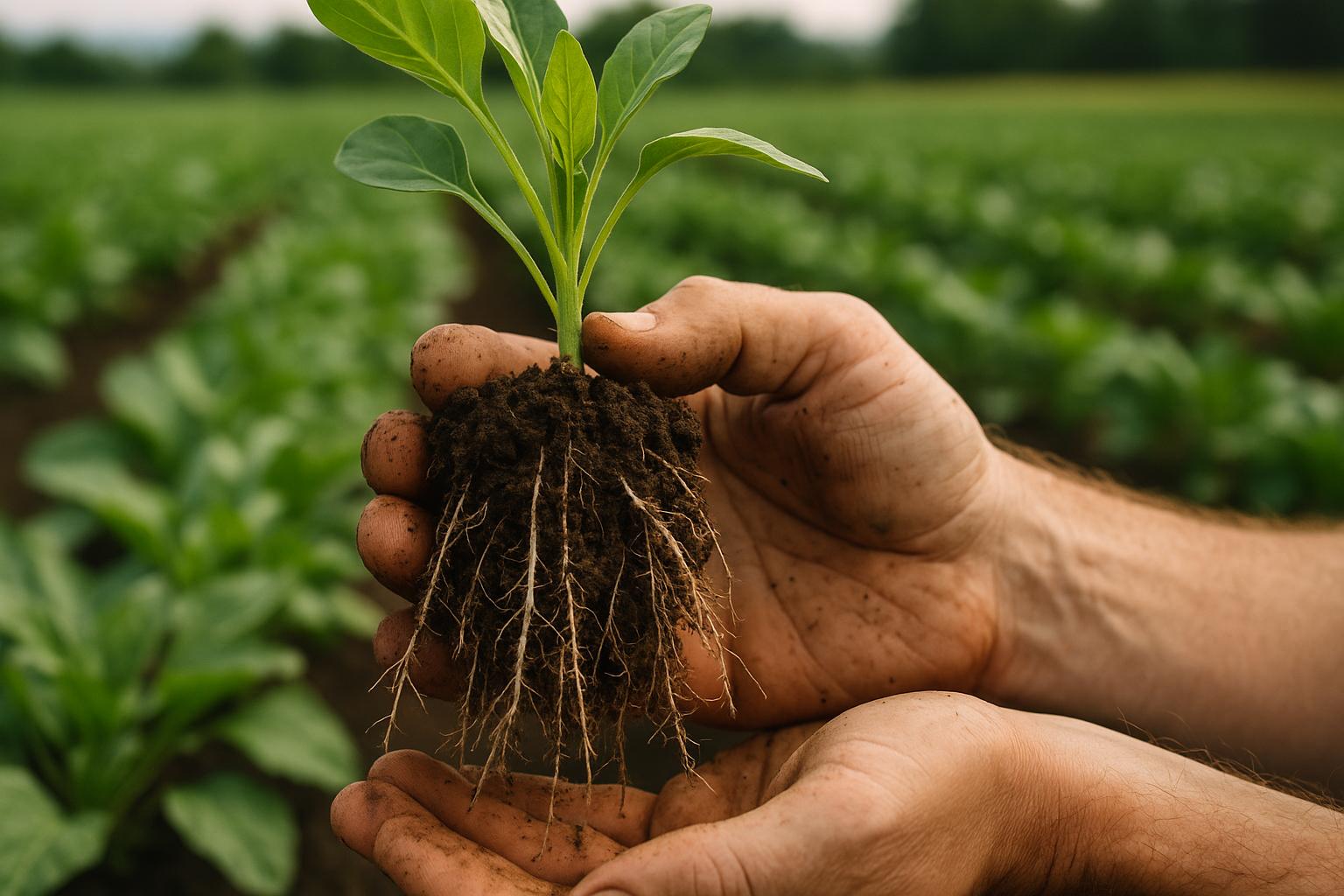When growers talk about boosting yields, they often focus on fertilizer schedules, seed genetics, or irrigation systems. But beneath all that is an underground network that’s changing the game—fungal root allies. More specifically, mycorrhizal fungi, a class of beneficial organisms forming symbiotic relationships with plant roots, are helping growers unlock the true potential of their soil without relying solely on synthetic inputs.
The move toward fungal partnerships is a reaction to practical issues like depleted soils, unpredictable weather, and rising input costs, not a fad. The potency of these fungal companions is receiving significant attention as more growers look for economical, sustainable strategies to increase crop resilience and yield.
What Are Fungal Root Allies?
Fundamentally, these are naturally occurring fungi, mostly belonging to the mycorrhizal family, that spread their reach by colonizing plant roots and growing through thin filaments known as hyphae. Consider them to be minuscule amplifiers of roots. They improve the plant’s absorption of water and nutrients, particularly trace minerals and phosphorus, which are frequently trapped in inaccessible forms.
There are two major types:
- Endomycorrhizae, which penetrate root cells and form a highly efficient nutrient exchange.
- Ectomycorrhizae, which surround the root surface and are especially common in trees and forest systems.
While invisible to the naked eye, their impact is massive.
The Science Behind the Symbiosis
Through photosynthesis, plants provide the fungi with carbohydrates, which the fungi then use to deliver nutrients and enhance drought resistance. It’s an ecological optimization, not only a trade.
Research indicates that crops treated with mycorrhizal fungus exhibit a 15–20% increase in drought resistance and a 30% increase in phosphorus uptake. And that’s without adding more fertilizer.
These fungi restore the connections between yield and biology in tilled, sprayed, and impoverished soil.
Why Growers Are Embracing the Change
What’s prompting this quiet shift underground? It’s the convergence of practicality and necessity.
Growers are turning to fungal root allies because:
- Synthetic inputs are becoming more expensive and less effective as soils lose their structure and biological activity.
- Extreme weather events are making it harder to rely on traditional growing models.
Mycorrhizal fungi provide a buffer against both. They enhance water efficiency, reduce fertilizer needs, and improve root architecture.
In just one season, I could see the results in my own practice. With larger root systems and less indications of nutritional stress, the plants were clearly more resilient. Additionally, it lessened transplant shock, especially in peppers and tomatoes. Well-designed bioinoculants, some of which are sold under reliable formulas like purchase Nature Deep for fruits and vegetables, which incorporate microbial assistance without upsetting established soil systems, made the shift go smoothly.
Boosting Resilience and Reducing Inputs
The goal isn’t just bigger yields—it’s better balance. Fungal root allies are especially valuable in reducing nitrogen runoff and improving soil aggregation. Here’s how:
- Improved soil structure: Mycorrhizal networks create a sticky protein called glomalin that holds soil particles together.
- Nutrient recycling: Fungi help decompose organic matter and unlock nutrients that would otherwise go unused.
This natural efficiency translates to lower dependency on inputs and stronger performance in poor or marginal soils.
Beyond Tomatoes and Corn: The Bigger Impact
Not just veggies benefit from these fungus. They promote natural prairie restoration as well as orchards and cereal crops. For instance, their application in viticulture has increased grapevine resilience to diseases and, by improving nutritional balance, has enhanced flavor complexity.
Mycorrhizae have been demonstrated to improve bean density and lessen susceptibility to root rot in coffee and cacao systems. Fungi are gradually being acknowledged by the international agricultural community as important collaborators rather than unseen supporting actors.
“The greatest untapped resource in agriculture is the biology beneath our feet.” – Dr. Kristine Nichols
Common Misconceptions About Fungal Inoculants
Despite their benefits, fungal root allies are often misunderstood. Let’s clear up a few things:
- They’re not instant fixes: Fungal colonization takes time—typically weeks before benefits show above ground.
- They don’t replace good soil practices: They work best in combination with organic matter, reduced tillage, and diverse cover crops.
- Not all fungi are created equal: Strain quality matters. Commercial inoculants vary widely, and some don’t contain viable spores.
This is why sourcing matters. Products should be tested, viable, and compatible with your specific crop type.
Integrating Fungi into Your Growing Plan
You wouldn’t believe how simple it is. Mycorrhizal inoculants are available as root dips, granules, or powders. They can be mixed with compost tea, applied during transplanting, or applied during seeding.
Timing is key: Apply when roots are young and growing. Mature plants are harder to colonize. Use these tips:
- Avoid phosphorus-heavy fertilizers early on. They can inhibit fungal colonization.
- Use cover crops like legumes that support soil microbes and feed fungal networks.
This integration strategy works even in raised beds and small-scale gardens. You don’t need acres to see the benefits.
Real-World Grower Testimonies
Farmers across the globe are reporting measurable improvements:
- In a Kansas soybean trial, mycorrhizal applications led to a 12% yield increase over untreated controls.
- A strawberry grower in Salinas, CA saw faster flowering and tighter fruit clusters within the first season of inoculant use.
These instances are not unique. Mycorrhizal fungi are essential for minimizing nutrient loss and erosion, two of the most expensive problems in field agriculture, according to SARE (Sustainable Agriculture Research and Education).
FAQs
- Can I use fungal inoculants in hydroponic or soilless systems?
Some strains can adapt to inert media, but most thrive in environments rich in organic matter. Check product compatibility. - Do I need to reapply fungal inoculants every season?
Not always. In no-till or low-disturbance systems, fungal networks can persist. But heavily disturbed or tilled soils may need annual support. - Can I mix fungal inoculants with compost or worm castings?
Yes, as long as temperatures stay below 120°F and conditions remain moist. Fungi do well in microbial-rich blends. - Are these products safe for edible crops?
Completely. They’re naturally occurring organisms and are considered safe for organic certification in most regions.
Towards the Future: The Silent Underground Revolution
This is a paradigm shift rather than merely a trend. The fungi under our feet are pointing the way toward a more sustainable future as we shift away from extractive agriculture and toward regenerative systems. They create long-lasting soils, enhance water use efficiency, and replenish soil fertility.
Here’s something better to end with than a neat summary: Become interested. Pick just one crop. A portion of your garden or field should be inoculated. Measure, compare, and observe. Allow your plants to demonstrate the difference.
You don’t have to completely redesign your system. Simply make one deliberate, minor alteration underground. If you start there, you may discover that the most significant agricultural innovations come from what is subtly grown beneath the surface rather than from what is added above it.
Check out more blogs:
The Future of Rice Disease Management Lies in Systemic Fungicides Like Pulsor



